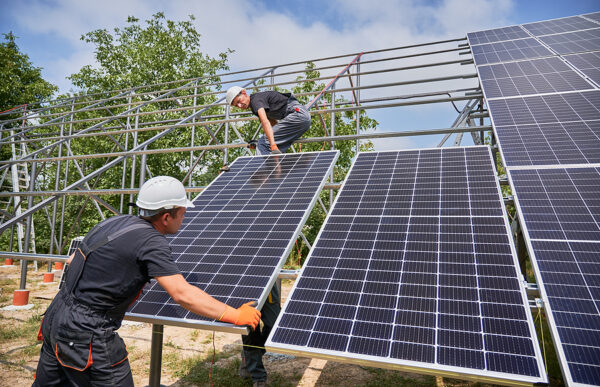The United States–and the rest of the world–is amidst a dramatic shift. For much of modern history, the reliance on fossil fuels as the main source of energy, while powering many technological advances, has resulted in significant changes to the Earth’s climate. To combat this, governments are pouring trillions of dollars into clean energy technologies. With clean and renewable energies growing at an almost unprecedented rate, many experts believe that the clean energy future is arriving faster than you think.

What is Clean Energy?
The terms clean, green, and renewable are often used interchangeably. However, there are distinct differences between these types of energy. Here are the key differences:
- Clean Energy: Produces no greenhouse gas emissions in the production or usage of energy.
- Renewable Energy: Produced from a source that is continuously replenished.
- Green Energy: Produced from a method and a source that has no negative impact on the environment.
In some cases, renewable energy might not be completely clean if it produces carbon emissions, such as what may be released by equipment and materials used to build infrastructure such as wind turbines or solar farms. According to the National Grid, most green energy sources are renewable, but renewable energy sources might not always be completely clean or green.
Types of Clean Energy
The US Department of Energy states that the clean energy industry generates hundreds of billions of dollars in economic activity each year. The development of these resources will enable the US to compete in the clean energy arena on a global scale. These energies include:
- Wind: Wind is harnessed and converted into energy through wind turbines.
- Solar: Converts sunlight into energy through photovoltaic panels or mirrors that concentrate solar radiation.
- Water: Hydroelectric power is generated by the flow of water through a dam or other diversion structure. As water flows downstream through the structure, the current turns turbines that generate electricity.
- Geothermal: Geothermal energy is generated from heat deep within the Earth when steam is extracted to turn a turbine within the geothermal plant. Northern California is home to the world’s largest single source of geothermal power.
- Bioenergy: Many plant- and algae-based materials can be converted into biofuels with a wide range of applications. Currently, biomass is the only renewable energy that can be used to make liquid transportation fuels such as gasoline, diesel, and jet fuel in the near term.
- Nuclear: Nuclear energy utilizes sustained nuclear fission to create energy. It has been used in the US for over 60 years and has proved to be both reliable and low-carbon.
- Hydrogen & Fuel Cells: Hydrogen is readily available from renewable sources like wind, solar, and geothermal.
While these energy sources are not new, there is increasing adoption of these technologies. For example, solar is one of the fastest-growing and most affordable sources of renewable energy on the market. As the cost has continued to decrease, more Americans are opting for solar energy. Additionally, nuclear power generates 20% of the electricity used in America. As these technologies continue to develop, it’s easy to see why the clean energy future is arriving faster than you think.
What is Driving This Shift?
There has been extensive debate and discussion about global warming and climate change for decades. However, recent factors, such as the global energy crisis that was brought on by Russia’s invasion of Ukraine, have accelerated the uptake of clean energy. At the onset of the war, much of Europe was heavily reliant on Russian fossil fuels.
In the United States, changing policies are accelerating the clean energy transition. By 2027, the US is on track to double its renewable capacity. Last year, the tax credit for renewables was extended to 2032. In addition, the majority of states (37 out of 50) have renewable energy portfolios that will support this growth. Because of this momentum, renewable energies are predicted to account for more energy production than coal by 2025. Even still, there continues to be fierce opposition within the US against limiting greenhouse gas emissions–primarily from oil companies and conservative groups.
Beyond policy and geopolitical factors, the cost of clean energy has fallen dramatically, making these technologies more accessible to Americans across the country. According to the New York Times, since 2009, the cost of solar power has fallen by 83%, while the cost of lithium-ion battery cells (like those used in electric vehicles) has fallen by 97%. A large contribution to this has been early government investments in clean energy technologies. Even now, there is heavy investment in this arena, most notable with the Biden Administration’s $1.2 trillion Infrastructure Investment and Jobs Act, which includes a $65 billion investment into clean energy transmission and grid infrastructure.
How Will This Change Our Lives?
The increased proliferation of clean energy sources will have a tremendous impact on our lives. According to the United Nations, here are some of the ways that it will benefit humans around the globe:
- Creating Jobs: Each dollar invested into renewable energy created three times the number of jobs than in the fossil fuel industry. While it is predicted that jobs will be lost in the fossil fuel industry, there will be a net gain of 9 million jobs by 2030 in the energy sector. Other industries, like auto manufacturing, are expected to gain 16 million jobs due to the demand for electric vehicles.
- Improving Health: Data collected by the World Health Organization estimates that 99% of the human population breathes air daily that exceeds air quality standards. The switch to clean energy alternatives will reduce the amount of unhealthy particles in the air we breathe.
- Reducing Costs: In many parts of the world, clean energy prices continue to drop. For many people, clean energy is more cost-effective than traditional fossil fuels. And, as prices drop, renewable energies will continue to grow more attractive, especially in low- and middle-income countries.
How Should Clean Energy Companies Respond?
Since the clean energy future is arriving faster than you think, clean energy companies with 75 to 6,000 employees will need to find a way to respond to this growing demand. With the industry on a rapid growth trajectory, companies will need to hire more employees, expand their services, and more to compete. Fortunately, HR outsourcing can help companies respond to these changes in the energy sector.
With an HR outsourcing partner, clean energy companies can focus on their core competencies, while their HRO focuses on redundant, repetitive, and time-consuming administrative tasks. With a reliable HR outsourcing partner like Corban OneSource, clean energy companies can feel confident that they can offer a better employee experience, remain compliant with HR and payroll regulations, and control HR costs.
Corban OneSource has extensive experience working with clients that have between 75 and 6,000 employees in the energy sector. When the clean energy future is arriving faster than you think, HR outsourcing services for energy companies can be a competitive advantage. Contact the knowledgeable team at Corban OneSource today.


